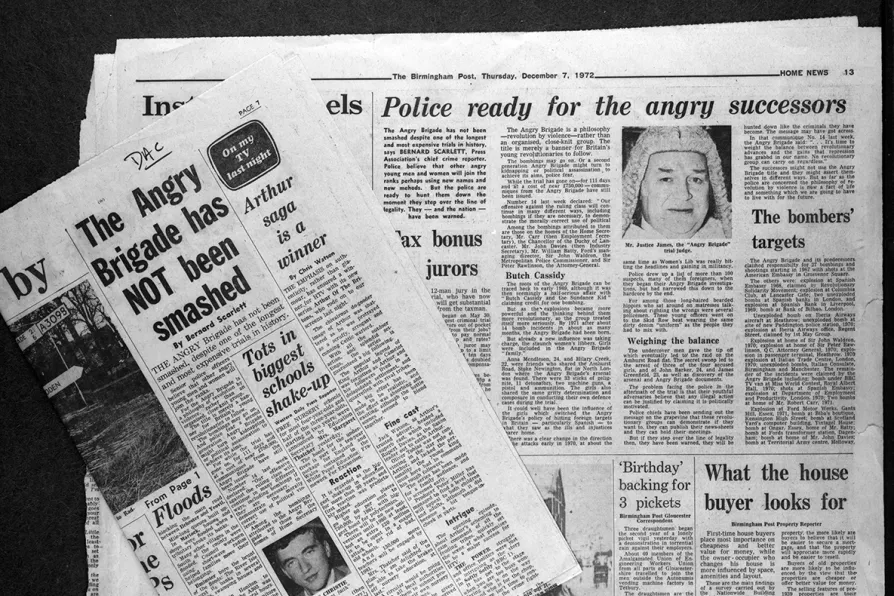Once the bustling heart of Christian pilgrimage, Bethlehem now faces shuttered hotels, empty streets and a shrinking Christian community, while Israel’s assault on Gaza and the tightening grip of occupation destroy hopes of peace at the birthplace of Christ, writes Father GEOFF BOTTOMS
With the recent release of Paul Thomas Anderson’s movie One Battle After Another, STEPHEN ARNELL gives the storied history of the British real-life left-wing urban guerillas


PAUL THOMAS ANDERSON’S timely One Battle After Another is a loose adaptation of Thomas Pynchon’s 1990 novel Vineland, depicting the decades-spanning activities of militant Weather Underground-style group the French 75 (named after the cocktail) and their foes, who include the US security establishment and their recent, occasional allies, The Christmas Adventurers Club, a secret organisation of anti-immigrant white supremacists.
“All hail St. Nick!” — The Christmas Adventurers Club slogan
So far, so Trumpian, especially in the light of successive waves of Ice (Immigration and Customs Enforcement) raids launched across the US, and the President’s attempt via executive order to brand antifa (anti-fascists groups), a “domestic terrorist organisation,” despite lacking both a formal structure or any clear programme of violence.
Still, as Shakespeare wrote, “The wish is father to the thought,” and Donald Trump’s desire to see antifa as an insurrectionist outfit (he has enough form in that direction) may actually come true if he pushes opponents too far. Which of course will give him the excuse to ramp up what appears to be increasingly violent pressure on anyone to the left of the late, unlamented, quasi-fascist US prelate Father Coughlin.
‘From this moment despair ends and tactics begin’ — Angry Brigade Communique 5 and 7
Turning to the subject of this piece, Britain’s homegrown real-life anarchist equivalent of the US’s Marxist-Leninist Weathermen, and other (but non-violent) groups, the Yippies and the Rainbow Coalition. This was the Angry Brigade, whose actions peaked between 1968-72, with a short-lived revival of sorts in the mid-1980s, resurfacing as the Angry Brigade II, part of the Irish Republican Socialist Movement.
The Angry Brigade: who they were, what they did, how they did it — and where are they now?
The group, which numbered both sexes, were mainly educated at Cambridge and Essex Universities, inspired by the international student protests of spring 1968.
The brigade instigated a string of armed actions against the British Establishment between 1968 and 1972. They targeted embassies, banks, a BBC Outside Broadcast vehicle destined for the 1970 Miss World Contest, and the homes of Conservative MPs with a series of approximately 25 small-scale non-lethal bombings. The attacks chiefly caused property damage, with just one person only slightly hurt.
Hardly comparable to, say, Germany’s Red Army Faction (aka the Baader–Meinhof Gang), who conducted scores of bombings, assassinations, kidnappings, bank robberies, and police shootouts over the course of their three-decade existence. Likewise, Italy’s Red Brigades who also pursued a far bloodier path than their north London peers.
That’s not to say the Angry Brigade had other, more deadly ambitions; on January 12 1971, the brigade attempted to assassinate employment secretary Robert Carr with bombs and at his home, a few months later (on May 4 1971), a device was discovered attached to the underside of Lady Beaverbrook’s car. Both these attempts came to naught.
The Stoke Newington Eight
Of those who eventually stood trial, known to history as the Stoke Newington Eight (a knowing throwback to 1969’s Chicago Seven in the US), four were found guilty and sentenced to incarceration of 10 years apiece.
Not really much to show for their actions, aside from a rather droll name, and an articulation for some of Great Britain’s educated youth about the rottenness of Britain at the time, plus of the world in general. One wonders what surviving brigade members would think of the situation today, if some or all have retained their old anarcho-radical beliefs.
One of the convicted quartet, Anne Mendelssohn, became a published poet under the literary pseudonym Grace Lake; she apparently kept to at least some of her former creed, but with a more individualist bent.
Angela Mason, who was acquitted, became a director of the LGBT rights group Stonewall and was awarded an OBE in 1999, promoted to CBE in 2007.
Although he definitely tried to assassinate Spanish dictator Franco some years earlier when he was 18, Stuart Christie was acquitted of being a member of the Angry Brigade and avoided prison, continuing to hew to his anarchist beliefs to the end of his life in 2020. His 2004 autobiography was titled Granny Made Me an Anarchist.
‘Just kick it till it breaks. Revolution’ — Communique 8
Fortunately, there’s a comparative wealth of documentaries about the Angry Brigade to check out if you’re interested in what the group stood for and got up to. These include a 1972 World in Action investigation, the BBC’s The Angry Brigade: The Spectacular Rise and Fall of Britain’s First Urban Guerilla Group and the 2002 BBC4 documentary The Angry Brigade.
Also in 2002, BBC Radio 4 broadcast Graham White’s The Trial of the Angry Brigade, which reconstructed the trial, with a cast that included Mark Strong, Kenneth Cranham, Juliet Stevenson and Tom Hiddleston. The play is also currently available on YouTube.
And some of the non-violent related ethos of the group may be said to continue to this day, in the provocative deeds of organisations such as Just Stop Oil and Palestine Action.

NEIL GARDNER listens to a refreshingly varied setlist that charts the band’s voyage from avant-garde experimentalists to techno pioneers

The fallout from the Kneecap and Bob Vylan performances at Glastonbury raises questions about the suitability of senior BBC management for their roles, says STEPHEN ARNELL

New releases from Nazar, Peter Gregson and Mesias Maiguashca











